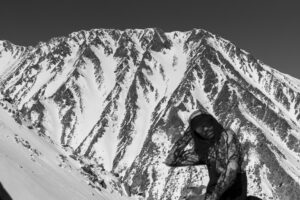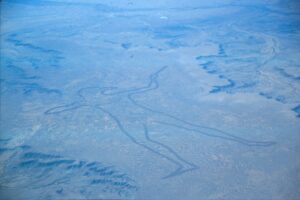Obituaries are telling, aren’t they? “I remember her coming into the Travel Bookshop in London as an old lady, sitting peacefully on the sofa but still exuding an air of curiosity. It was that, combined with prodigious energy that made her into such an inspiration to women travelers of today. Her aim was “to push the nose of my sailing boat into every creek and to point my skis down every possible gully of the mountain.”
Written by Sarah Anderson in The Independent, Ella Maillart’s obituary covers the broad strokes. Maillart was indeed an outstanding inspiration to women, initially through sport, then travel. Ultimately, she was an adventurer in the true essence of the word, in whatever realm she was involved in at the moment. She died in 1997, at 94 years old.

Ella Maillart.
Born in Geneva 1903, Maillart lived through two World Wars, the formation of the Girl Scouts, Prohibition, the first moon landing, the formation of the EU and the birth of the internet. A life spanning as many centuries as Maillart’s did experiences much progression. But for Maillart, merely experiencing progression dissatisfied. Instead, she was instrumental in the progression of women as athletes and adventure travelers.
For women in the early 20th century, sport was only beginning to catch on. In the early decades, only women of higher social class played sports. Horseback riding or skiing, for example, were almost exclusively for families who could afford such luxury. Status through these trendy pastimes was part of the sporting package.
Around the world, it was a long, slow creep for women in athletics. In Japan, it was only in the 1920s that women were even allowed to participate in sport at school. In 1967, Kathrine Switzer famously ran the Boston marathon disguised as a man, because it was believed that females weren’t physically able to run such distance. It took a further five years before women were actually allowed to enter the race.

Maillard had already been a keen weekend skier when in 1913, she and her family moved to a lakeside village near Geneva. Her mum had taken her to the slopes each Sunday, but at the lake, the 10-year-old girl first experienced the joys of water. Sailing became a favorite pastime.
By the age of 13, she had won her first sailing competitions. Sailing then took her to Corsica, then Sardinia, Sicily, the Ionian Islands and Ithaca. Maillart was so at ease on the ocean that for a time, she worked on a boat sailing the Atlantic. Young, dynamic and driven, her prodigious energy drove her forward.
She represented Switzerland in international sailing events during the 1920s and 30s and was the only woman among 17 Swiss athletes at the 1924 Olympics. Then, for the first half of the 1930s, she returned to her childhood sport and represented her country in downhill skiing.

Ella Maillart racing during the 1930s. Love those baskets!
In 1931 and 1932, she also captained the Swiss women’s field hockey team. She’d actually founded the first women’s field hockey team in Switzerland when she was only 16 years old.
Recreational skiing was still so new that many of the world’s most popular resorts were in their infancy. Women whizzing downhill at speeds of 120kph was hardly commonplace. Neither was it common to work as a stunt woman or actress in mountain films, as Maillart had.
She was evidently happiest when free to explore a variety of destinations and pastimes. She abolished consistency in favor of remaining true to her evanescent energy.
Ordinarily, pioneers become associated with an icon. Think of Coco Chanel in fashion or Marilyn Monroe on the silver screen. Amelia Earhart became an icon of aviation.
But you won’t find tales of an “iconic” Maillart who had won over media through interviews or graced the cover of glossy magazines. She is unknown in the iconic sense, despite her contribution to women’s sport.
Perhaps her personal life suggests why this became the case. In a time when same-sex relationships were barely whispered about, she carried on an open romance with Annemarie Schwarzenbach, an author known for her androgynous style and drug addictions. Maillart openly states her preference for women as partners.

Maillard and her girlfriend Annemarie Schwarzenbach were a controversial pair in 1939.
In time, Maillard turned from competitive sport to travel — more accurately, a travel style where she was willing to endure hardship, in order to explore anywhere but Europe.
In 1932, she traveled to Russian Turkestan and the Tien Shan, among Kirghiz, Kazakhs and Uzbeks. Three years later, she completed a seven-month trek from Beijing to Kashmir, through Chinese Turkestan. She and Schwarzenbach were among the first women to take the northern route through Afghanistan, via Herat. She also explored Turkey, India, Iran and Afghanistan before finally settling in India and becoming a respected writer.
When Nepal opened its borders to tourism in 1951, Maillart did more than travel there — she ran cultural tours for six months of the year from the early 1950s to 1987, returning to the Swiss slopes the rest of the time.
To some people, sports successes like Maillart’s would have been enough, but she always yearned for a life of personal freedom. Sport and travel were two of her doorways to that freedom. “Sometimes I believe that skiing is responsible for having made me a rolling stone,” she wrote in her autobiography, Cruises and Caravans. “As soon as winter arrived, visions of skis swishing through new snow filled me with such feverish longings that wherever I was, I interrupted what I was doing… and went to the hills.”
Among her legacy, she left seven books in English, seven in French, four films and photographic exhibitions. “Ask yourself unceasingly, ‘Who am I ?’ And through this constant query, you will come to know, that you are the Light of Consciousness,” she liked to say to her companions, during the tours she gave in Nepal.






